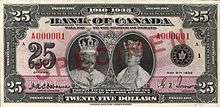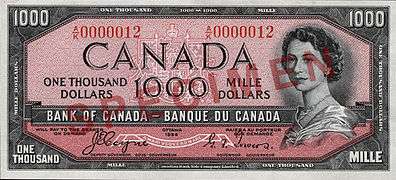Withdrawn Canadian banknotes
Banknotes that are no longer in issue in Canada, and are being actively removed from circulation, are said to be withdrawn from circulation.
Current issues
The Bank of Canada, Canada's sole issuer of bank notes, currently issues five different denominations ($5, $10, $20, $50 and $100). Smaller denominations have been replaced by coins, and larger ones are felt to be no longer required in an era of electronic transmission of most large transactions. Despite competition from some more valuable foreign notes (most notably, the 500 euro banknote), there are no plans to re-issue Canadian banknotes larger than $100.
Defunct currency


.jpg)
Notes issued by these former issuing authorities are considered to be withdrawn from circulation:
- Colonial governments, prior to each province or dominion entering confederation.
- The Dominion of Canada between 1870 and 1935, which issued notes in denominations of 25¢, $1, $2, $4, $5, $50, $100, $500, and $1,000
- Canadian chartered banks, from pre-Confederation to 1944. Further information: Canadian chartered bank notes
Bank of Canada notes


All Bank of Canada notes issued prior to the current Frontier Series are being actively withdrawn from circulation.[1] The following Bank of Canada denominations included in previous series have been permanently retired:
$25
The $25 note was issued only in 1935, to commemorate the silver jubilee of King George V. As with other 1935 issues, separate English and French versions were printed. This was a limited release that was never printed in large quantities. The note was coloured an appropriate royal purple; both the King & his consort Queen Mary were featured, with Windsor Castle appearing on the back. The $25 note was withdrawn from circulation in 1937.[2]
$500
The $500 denomination was included only in the 1935 series. No note of this denomination has been printed since. The note was coloured sepia, or burnt sienna; the face featured Sir John A. Macdonald, and the back depicted a fertility allegory. The $500 note was withdrawn from circulation in 1938.[2]
There had been two previous printings of the $500 note by the Dominion of Canada, one in 1925 featuring King George V, and one in 1911 picturing Queen Mary. Of the latter, only three are known to still exist, one of which sold for US$322,000 in a Heritage auction in October 2008.[3] It is unlikely that further 1911 notes survived the Depression.
$1
Printing of the $1 note ceased in 1989 after the release of the loonie (in 1987) had been implemented. These notes are virtually never seen in circulation today. The most recent banknote series that included the $1 note was the Scenes of Canada, with the $1 note released in 1974, coloured green and black. The face featured a portrait of Queen Elizabeth II; the back featured an image of Parliament Hill from across the Ottawa River, with log driving activities taking place on the water.
$2
Printing of the $2 note ceased on February 18, 1996, with the release of the toonie, a coin that replaced it. These notes are virtually never seen in circulation today. The most recent banknote series that included the two-dollar note was the Birds of Canada series in 1986, in which the two was a terra cotta colour. The face featured a portrait of Queen Elizabeth II; the back featured a meadow scene with two robins. Prior to the withdrawal of the $1 note, the $2 was not as widely circulated and was difficult to find in some regions, Alberta in particular. After the $1 note was withdrawn, the $2 was much more widely circulated.
$1,000
Printing of the $1,000 note ceased in 2000. The denomination was withdrawn on the advice of the Solicitor General and the Royal Canadian Mounted Police (RCMP), as it was often used for money laundering and organized crime.[4] The Bank of Canada has requested that financial institutions return $1,000 notes for destruction.[5] The most recent issue of this denomination was in 1992 as part of the Birds of Canada series. It was pink in colour, featuring Queen Elizabeth II on the face, and two pine grosbeaks on the back.
Status of withdrawn banknotes
Currency withdrawn from circulation remains legal tender, but this does not obligate any creditor to accept it as a medium of exchange.[6] Withdrawn currency is usually exchanged at commercial bank branches, though some banks require that exchangers be bank customers. The bank then returns the withdrawn currency, together with worn out currency, to the Bank of Canada for destruction.
Liabilities for outstanding provincial and Dominion of Canada notes was transferred to the Bank of Canada in 1935, and liability for chartered bank notes in 1950. As of December 31, 2015, the total value of provincial, Dominion, chartered bank, and discontinued Bank of Canada denominations still outstanding is $838 million, of which more than $794 million is in $1,000 notes.[7] A liability for this amount remains on the Bank of Canada's books up to the present day.
References
- ↑ "Bank of Canada Employee Handbook, page 9" (PDF). Bank of Canada. Retrieved 15 October 2016.
- 1 2 Graham, R. J. (editor) (2012). Canadian Government Paper Money (25th ed.). Charlton Press. p. 206. ISBN 978-0-88968-353-2.
- ↑ 2008 September Long Beach, CA CAA Signature Auction #3502 Heritage Auctions
- ↑ "Bank of Canada kills $1000 bill". CBC News. 2000-09-26. Retrieved 2007-06-10.
- ↑ "Bank of Canada to Stop Issuing $1000 Note". Bank of Canada. 2000-05-08. Retrieved 2007-07-27.
- ↑ Past Series. Bank of Canada http://www.bankofcanada.ca/banknotes/bank-note-series/past-series/. Missing or empty
|title=(help) - ↑ "Bank of Canada Banking and Financial Statistics, February 2016, page 105" (PDF). Bank of Canada. Retrieved 15 October 2016.